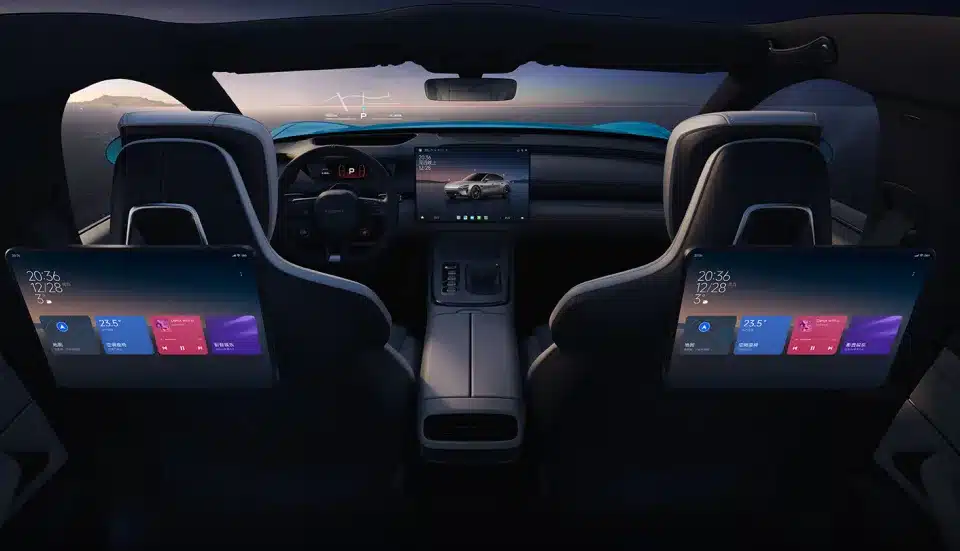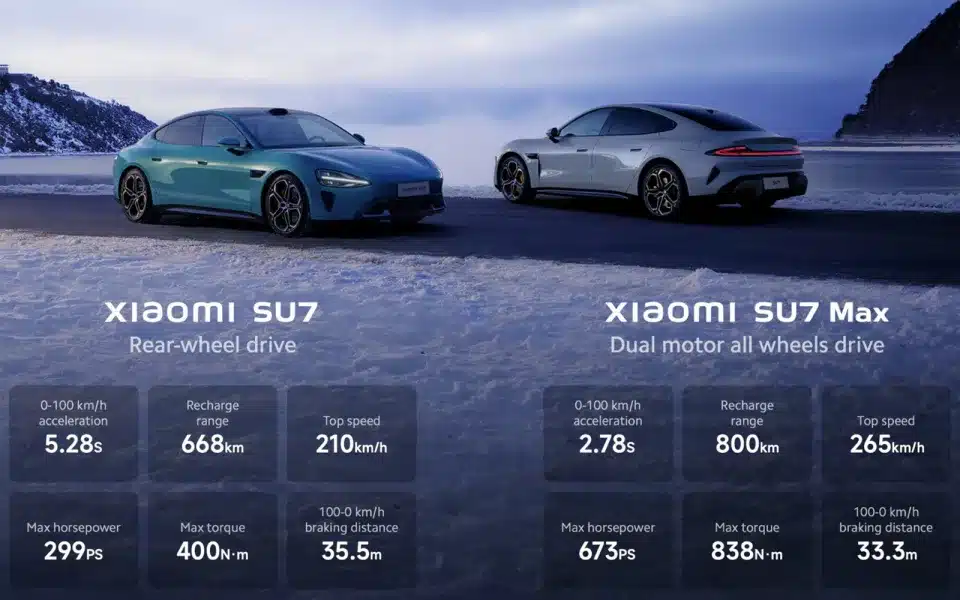
Xiaomi launches its own electric car! The SU7 has finally been unveiled, and it’s causing quite a stir with its promise. Will the Chinese electronics giant dethrone Tesla? Find out all you need to know!
When you hear “ Xiaomi “you’re probably thinking of cheap smartphones, televisions or connected bracelets approximate operation.
Since itsndation in 2010, the Chinese firm based in Beijing’s Haidian District, has established itself in virtually every electronics segment, from scooters to laptops and connected scales.
Until now, however, there has been one market it had not yet tackled: the electric car.. This is now a reality.
This December 28, 2023, Xiaomi unveils its first SU7 vehicle. It’s a sedan based on the Modena architecture it created.
Her HyperEngine electric motors can reach 21,000 rpm, and its chassis is directly stamped by molding machines with a clamping force of 9,100 tons: that’s more than Tesla’s.
Visit dimensions are comparable to a BMW 51440 mm high, 1963 mm wide and 4997 mm long. Choose from three colors: aqua blue, gray or olive green.
This will be available in two versions. The SU7 with rear-wheel drive and a single engine, and the dual-motor SU7 Max with all-wheel drive.
A car designed by the world’s automotive elite

Xiaomi didn’t do things by halves to bring this project to fruition. It has recruited talent from the global automotive industrysuch as Tianyuan Li, responsible for the iX range and BMW’s iVision concepts.
Li volunteered to lead the design team, and was joined by James Qiu, who had worked on Mercedes Benz’s Vision EQXX. Later, the BMW veteran Chris Bangle joined them as design consultant.
At the presentation event, Xiaomi CEO Lei Jun highlighted the generous legroom and trunk space: 517 liters in the rear, 105 liters in the front.
He also emphasized the teardrop-shaped headlightswhich resemble the Chinese character for “rice” and also serve as the “mi” in “Xiaomi”. In addition, the halo-shaped rear brake light consists of 360 LEDs.
Despite the rise of touch controls in cars over the last few years, manufacturers have realized that the users prefer physical buttons.
The SU7 will offer such buttons for air conditioning or seat adjustment. A line of buttons can also be fitted as an option behind the central screen.
Another interesting point: the door handles are half hiddento facilitate use in cold weather. The kind of detail that makes all the difference!
HyperOS: an entertainment system designed by Xiaomi

As you’d expect from a smartphone giant, Xiaomi has created its own HyperOS entertainment system for its vehicle.
This is powered by a Qualcomm Snapdragon 8295 processor and boots up in 1.49 seconds. It lets you access your media, adjust the seats, or even control your Xiaomi devices via a 16.1-inch 3K screen.
Optional, Xiaomi Pad tablets can be fitted on 22.5W magnetic ports behind the front headrests. The user interface on the central screen can also be split into three windows for multitasking.
You can case the screen of your Xiaomi smartphoneand 23 Dolby Atmos speakers for music and video sound.
In addition, the Xiaomi CarlOT ecosystem will be open to third parties. As an example, Lei cited a connected seat capable of alerting you if your seatbelt is not fastened.
Visit iPhone users will also be able to enjoy features such as CarPlay and AirPlay wireless connectivity, or iPad mounting on headrests.
800 km range, autonomous driving… the Tesla Model S dethroned?

In terms of performance, Xiaomi already claims to have dethroned Tesla. The SU7 Max will offer maximum range of 800 kilometers according to the Chinese CLTC test, and acceleration from 0 to 100 km/h in just 2.78 seconds. That’s better than the Tesla Model S and Porsche Taycan Turbo.
One of the reasons for this is the 101kwH 800V high-voltage battery supplied by manufacturer CATL. It offers range of 220 km for a 5-minute charge390 km in 10 minutes, and 510 km in 15 minutes.
However, the basic model will only allow a load at 400v for its smaller 73.6 kWh battery. Maximum range will therefore be limited to 668 km.
The SU7 will also offer autonomous driving capabilitiesthanks to the Xiaomi Pilot platform powered by a Nvidia Drive Orin processor (two for the Max version) and a set of sensors.
A roof-mounted Lidar provides visual range of 200 metres and pixel accuracy to within 0.1 metres. This will enable better detection of small obstacles.
Video demos show that the car can navigate a busy street despite various obstacles, and park autonomously in small spaces. What’s more, the company promises that its sensors can withstand snow and rain.
Some tests of autonomous driving will be conducted in over 100 Chinese cities during 2024. However, it remains to be seen when the government will allow autopilot to be used throughout the country.

Towards a launch in France? Price and release date
In the future, software updates are planned and the future HyperEngine V8s engine will be able to reach 27,200 rpm. It is already ready for mass production and will equip vehicles from 2025.
The company also announces a new-generation engine technology based on carbon fiber, capable of reaching a staggering 35,000 rpm. However, it will not be ready for several years yet…
Visit of the SU7 and SU7 Max have not yet been announced. by Xiaomi, but don’t expect low-cost. And unfortunately, sales outside China will certainly be delayed…
Our blog is powered by readers. When you purchase via links on our site, we may earn an affiliate commission.